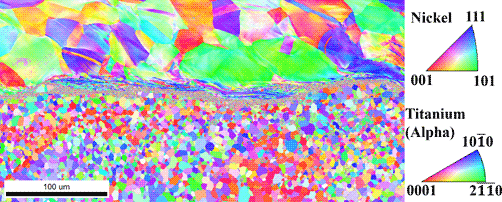No CrossRef data available.
Article contents
A Detailed Interface Characterization of the Explosively Welded Three-Layered Ti Gr 1/Alloy 400/1.4462 Steel Clads Before and After Heat Treatment
Published online by Cambridge University Press: 24 November 2021
Abstract

The presented research focused on the microstructural characteristics of explosively welded three-layered Ti Grade (Gr) 1/Alloy 400/1.4462 steel clads before and after heat treatment being of large practical potential. Scanning electron microscopy (SEM) analyses have shown that both interfaces formed between the plates are continuous and without defects. The in-depth examination was dedicated to the upper Ti Gr 1/Alloy 400 interface, located closer to the explosive material, therefore, subjected to more extreme welding conditions. The presence of cubic phase Ti2Ni, hexagonal phase Ni3Ti, and tetragonal phase (CuxNi1−x)2Ti were confirmed within the melted zones, which slightly widened due to annealing, being an essential step in the manufacturing of these modern materials. Transmission electron microscopy observations in the nano scale confirmed the preliminary chemical composition analyses collected with energy-dispersive X-ray spectroscopy in SEM. They additionally revealed the interface zone microstructure transformation due to the annealing. It was evidenced that initially mixed phases in the form of grains, after heat treatment formed irregular bands arranged in the following sequence: Alloy 400/Ni3Ti/(CuxNi1−x)2Ti/Ti2Ni/Ti Gr 1. A clear segregation of Cu and Ni forming two separate layers was also noticed. These diffusion phenomena may influence the strength of the final product, therefore need further studies regarding the prolonged annealing state.
Keywords
- Type
- The XVIIth International Conference on Electron Microscopy (EM2020)
- Information
- Copyright
- Copyright © The Author(s), 2021. Published by Cambridge University Press on behalf of the Microscopy Society of America




